Userpilot Alternatives: Are They Really Worth It?

You may wonder: “Why is Userpilot writing about Userpilot Alternatives?!”
Well, that’s because there are plenty of all these blogs “15 alternatives to {Brand Name} that are equally good” that are…plain wrong.
Written by content writers who have never used any of those tools, and frankly – have no clue what they are talking about.
And these posts are literally not helping anyone.
They are not helping you – the potential user; they are not helping our smaller competitors, who find themselves juxtaposed with enterprise software for a completely different user persona, and it’s not helping us – when we get leads that want something we can’t offer anyway. Because we’re just a different kind of onboarding tool!
Look – why not just be honest? It’s gonna save everyone’s time. Hey, we don’t want to waste your time if Userpilot is something you’re not looking for!
So we’ve classified the different alternative onboarding tools by a) user persona and b) JTBD (Job-To-Be-Done – in other words, what you want to use the tool for).
That way you’ll see there aren’t in fact 15 Userpilot alternatives.
And we’re writing honestly about them. Because still – there are some differentiators that may affect your choice.
And we want you to make that informed decision before you buy.
TL;DR
- User onboarding tools help new users navigate your product and increase their chances of activation.
- You can classify onboarding tools by different user personas, including small SaaS businesses, mid-market SaaS companies, and enterprise SaaS businesses.
- Userpilot is a Product Growth Platform that assists SaaS businesses in enhancing self-service support with checklists and a resource center, creating tooltips, and surveys without coding. It also provides user analytics and a sentiment suite to improve user engagement, adoption, and revenue growth.
- Best Userpilot alternatives include Appcues, Pendo, UserGuiding, and Walkme.
- Userpilot is the best choice for mid-market companies – offering the best value-for-money starting at $249 with unlimited feature usage, completely interactive walkthroughs, NPS, micro surveys, resource center, and user analytics. Book a Demo to learn more!
![]()
Try the best onboarding tool for your SaaS now!

What are user onboarding software applications?
User onboarding tools allow you to build in-app product tours to guide new users through your product, thus significantly improving the chances they will actually activate. A digital adoption platform can help product teams create step-by-step tutorials and reduce support tickets.
Customer success teams can use these tools to enhance user productivity and increase feature adoption during the free trial.
You can choose a digital adoption platform that better suits your needs and budget. Here are some ways to classify onboarding tools:
Onboarding tool classification for different user personas
A bootstrapped SaaS startup with 3 employees and $10,000 in MRR does not have the same needs as a big enterprise.
That seems obvious, right? And yet, most “alternatives” posts miss the mark completely and don’t classify the tools by user persona.
So here we are:
- Small SaaS businesses/Bootstrapped Startups
As a really small SaaS, there are two things you should care about most in a user onboarding tool:
- price
- ease of use
As your team of 4 is trying to make it (and not break it!), you won’t have the opportunity to use all the sophisticated features a mid-market tool has to offer. You have neither the time nor money to waste on developing product tours from scratch or using a complex digital adoption platform.
Once your startup grows and “graduates” from using these simple and affordable tools, it will be time to upgrade to something more sophisticated.
- Mid-market SaaS companies
When you’re on the growth path, you hire a product team and your Product Growth Manager/ Product Marketing Manager wants to improve user activation, product adoption, and retention.
You need to give them the right tools to do that – ideally without much involvement from your dev team. One that would allow them to build sophisticated in-app experiences such as branched interactive walkthroughs with steps triggered by custom events, welcome screens, tooltips, or micro surveys to collect user feedback and NPS.
And most importantly internal tools – one that would allow them to analyze their results, A/B test different versions and copy, and pick the best solutions to improve their product metrics.
You’re also starting to pay attention to security and integrations.
- Enterprise SaaS companies
As a large enterprise, often the main factors that determine your choice of an onboarding tool are:
- whether the tools can integrate with your existing tool stack.
- whether the company offers the required quality and security standards, often backed by certifications such as SOC 2 Type II.
Onboarding tool classification for different Jobs-to-be-done
But are you looking for user onboarding tools at all? Or are you looking for an employee onboarding tool? Are you going to use it for a mobile app or a web app?
Will you run it on your product, or on a third-party product such as Salesforce or Hubspot?
Again, these are mission-critical questions that are often gracefully overlooked by the authors of “Userpilot alternatives”-like blogs.
What job are you “hiring” the tool for? Will it fit your use case?
What is Userpilot?
Before we dive into Userpilot alternatives, we need to discuss the product we will be comparing other products to.
Userpilot is a Product Growth Platform that helps SaaS businesses to build new user onboarding, secondary onboarding, contextual hints, and onboarding checklists, without writing a line of code.
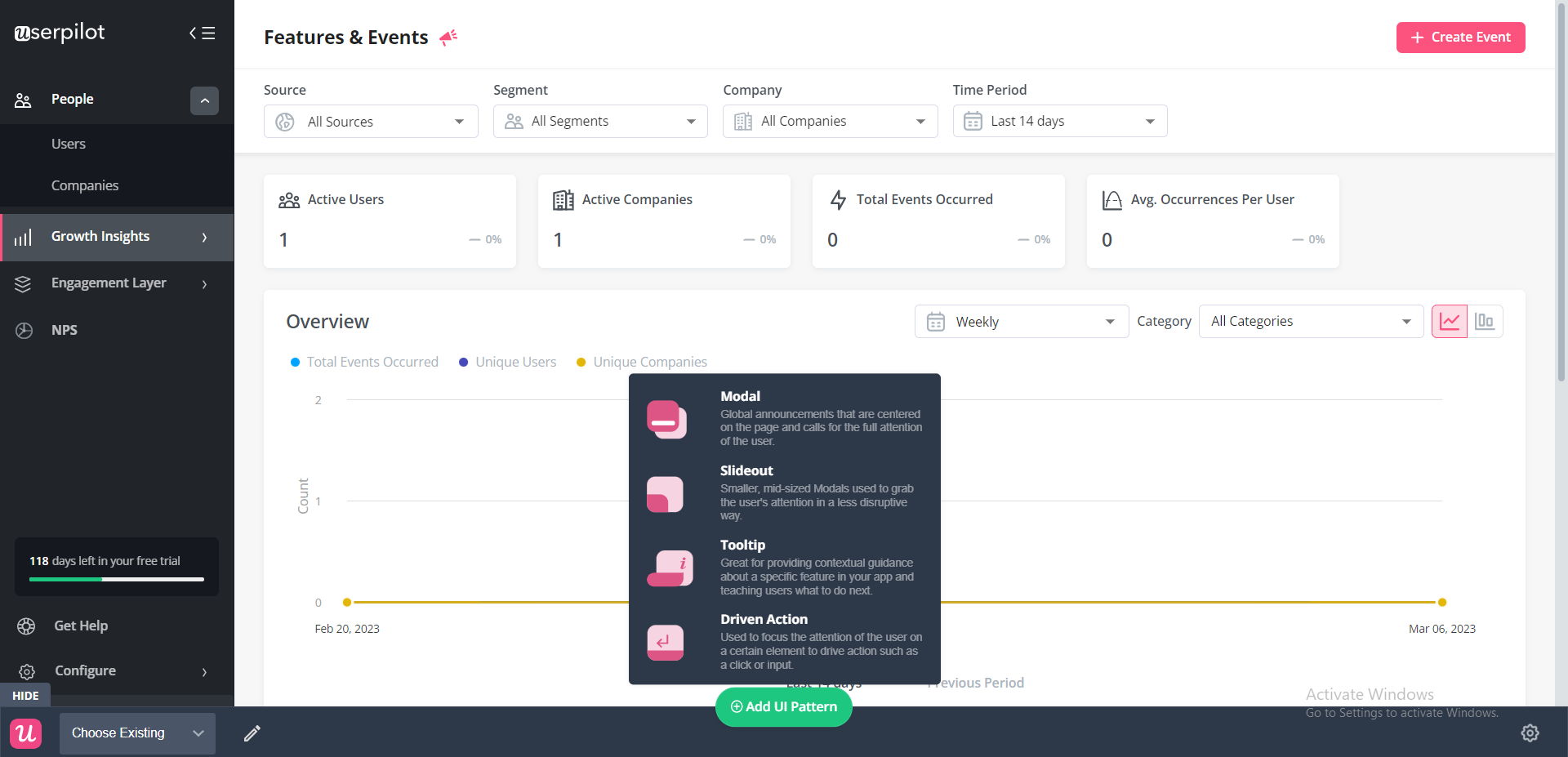
Create different UI patterns with Userpilot.
It also offers integrated user analytics and a user sentiment suite – with in-app surveys to collect feedback, and NPS surveys to gauge user satisfaction.
All this helps you to improve user experience and engagement, lead more users to activation, help them adopt secondary features, and even push for upgrades and get more expansion revenue.
Userpilot features
With Userpilot’s features, you get access to everything you need to create bespoke onboarding experiences, by triggering contextual in-app flows to specific user segments created based on product usage and in-app behavior.
Userpilot offers:
- Interactive user onboarding – Personalize customer onboarding to drive customer success. Userpilot’s branched walkthroughs and interactive product tours can be personalized to each user segment and help you with onboarding users more effectively. Create in-app experiences to guide user activation and user adoption.
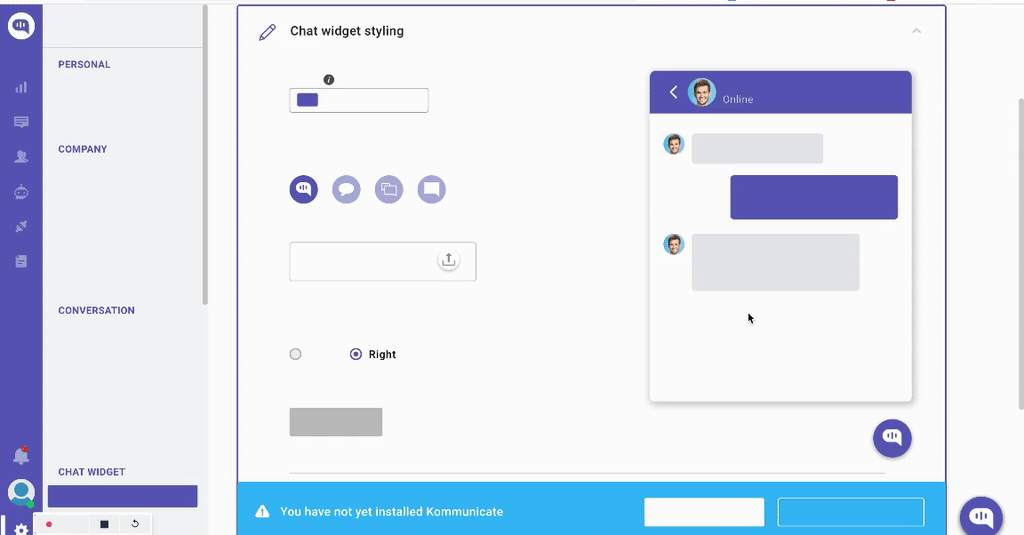
Create interactive walkthroughs with Userpilot.
- Secondary/ Continuous onboarding – With Userpilot’s no-code builder, you can create modals, tooltips, and in-app messages to drive secondary feature discovery and product adoption.
- Event tracking and feature tagging – Better understand your users, identify how they interact with your product and in-app content, and target ways to improve their experience.
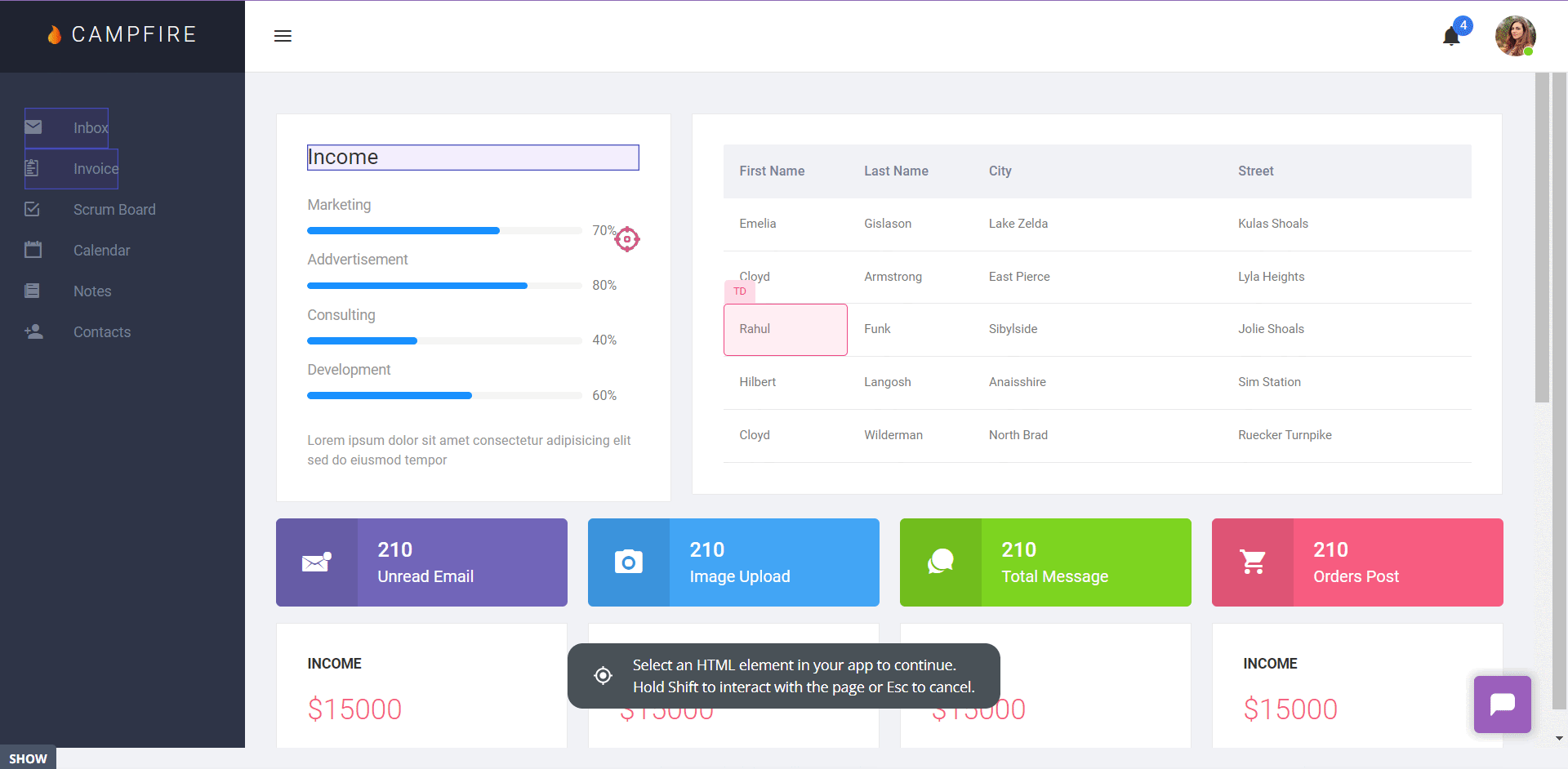
Tag different UI elements with Userpilot.
- Feature adoption with onboarding checklists – With Userpilot, checklists are simple to set up. You can even trigger targeted interactive tips, guides, and flows directly from a checklist.
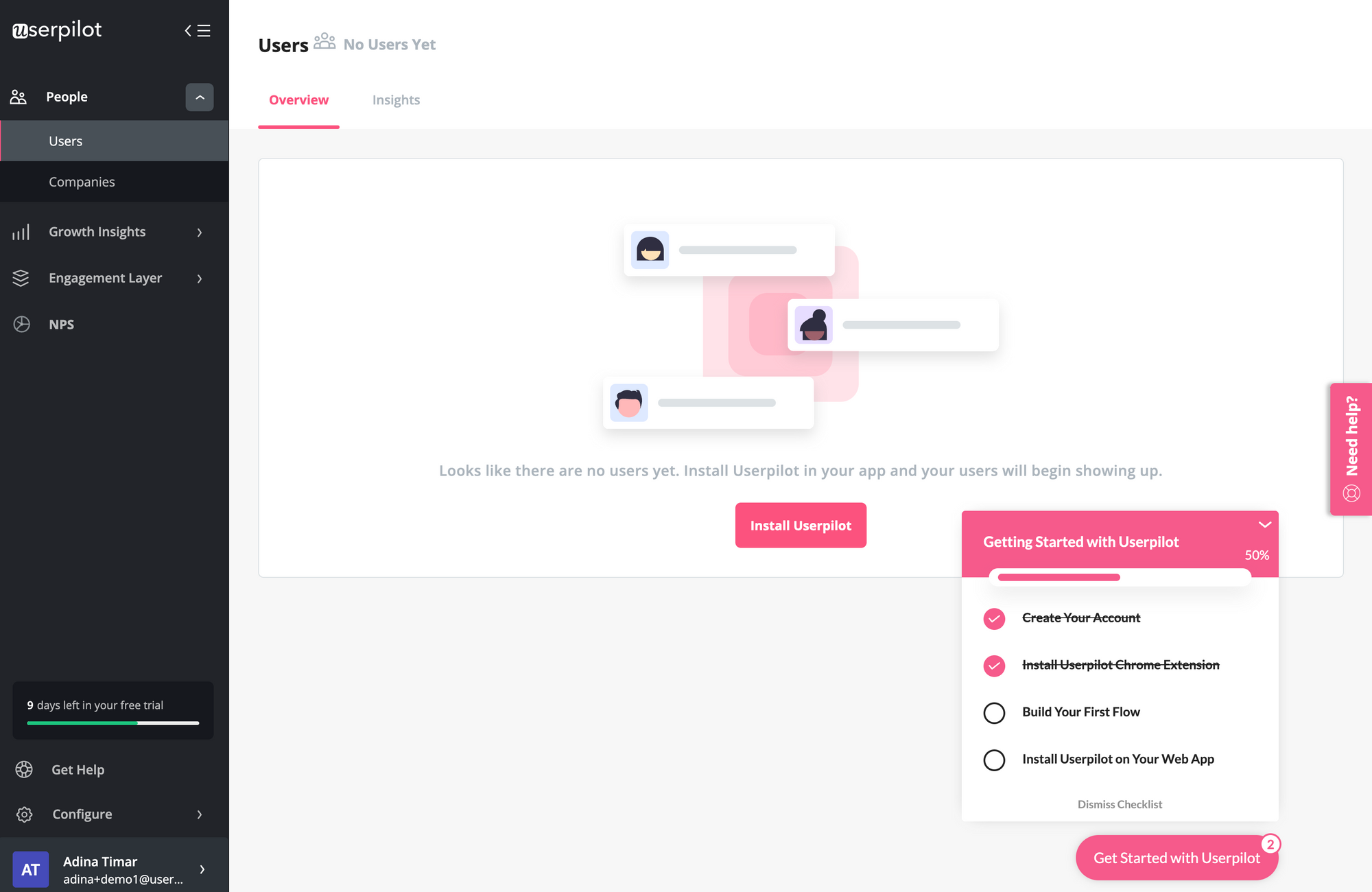
Create onboarding checklists with Userpilot.
- Learning management system with a Resource Center – Userpilot has a powerful array of self-service support options to help you provide a meaningful support system exactly when your users need it. Userpilot’s Resource Center offers you to create different modules with a huge range of content types, display relevant content to specific user segments, and understand how users engage with each module with detailed analytics.
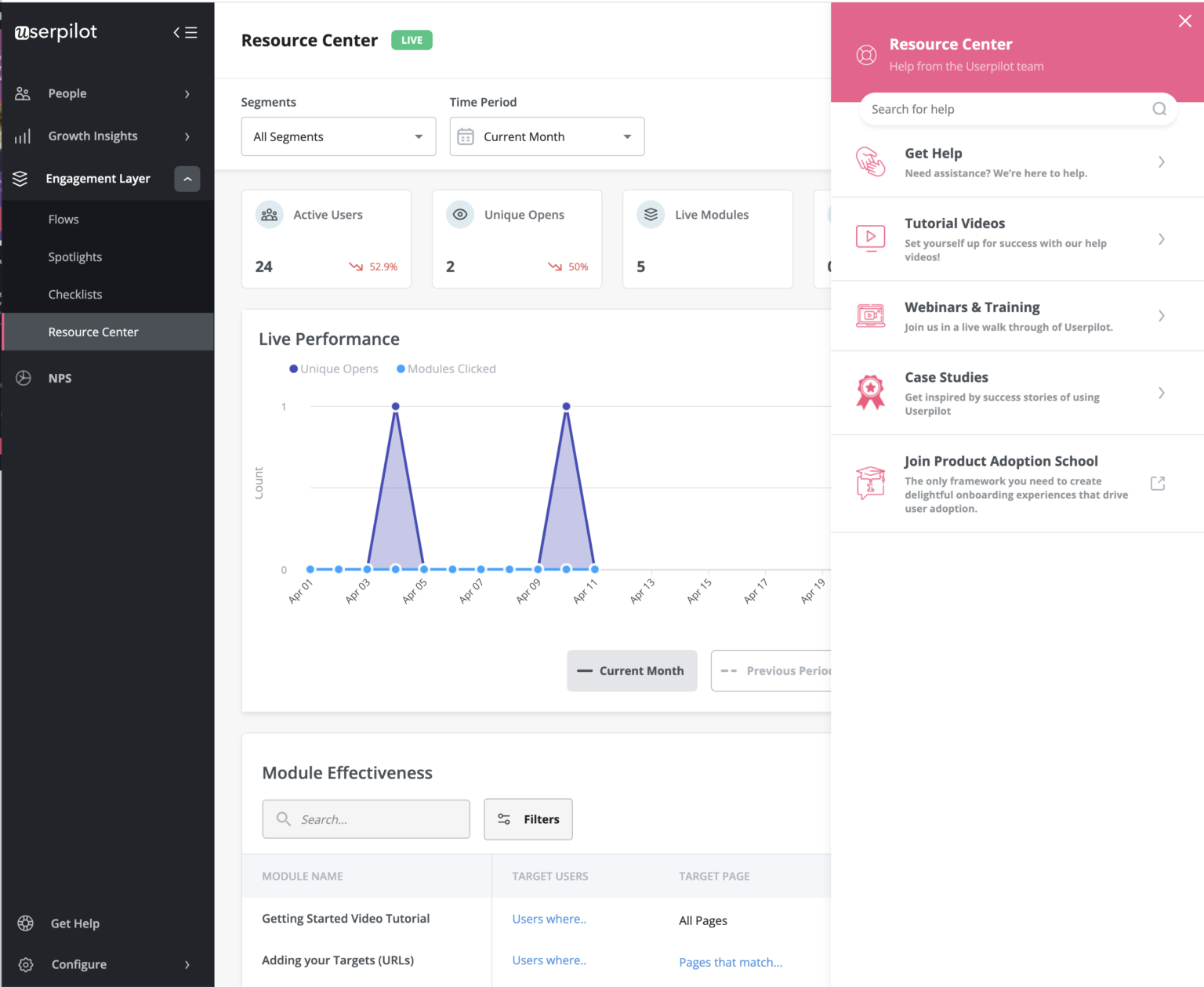
Create a resource center with Userpilot.
- Collect contextual customer feedback in real-time – Collect feedback to improve user onboarding experiences with customizable in-app surveys. Choose when and where in your app it makes sense to launch them.
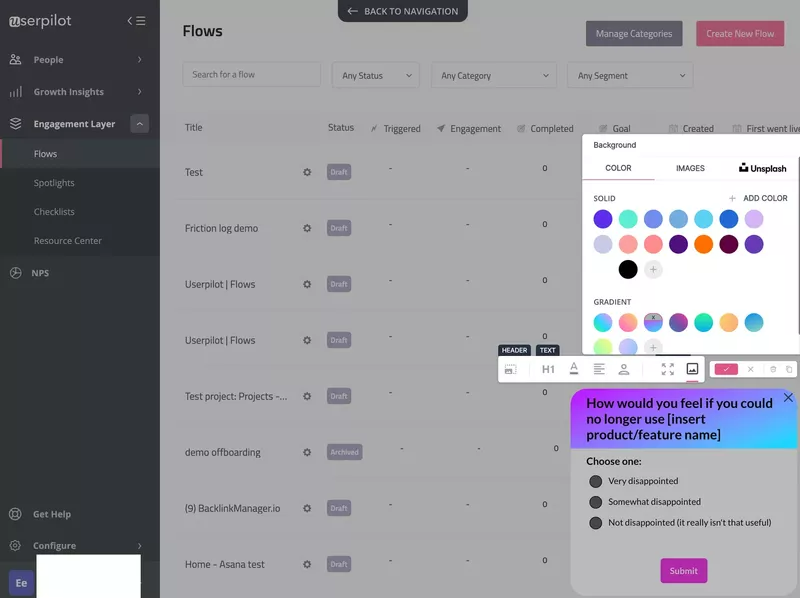
Create and customize in-app surveys with Userpilot.
- Built-in NPS survey – Quickly create, customize and launch NPS surveys that fit the look and feel of your brand. Add follow-up questions to understand the ‘why’ behind decisions, tag and analyze responses, and monitor at specific intervals over time to see how your NPS score changes.
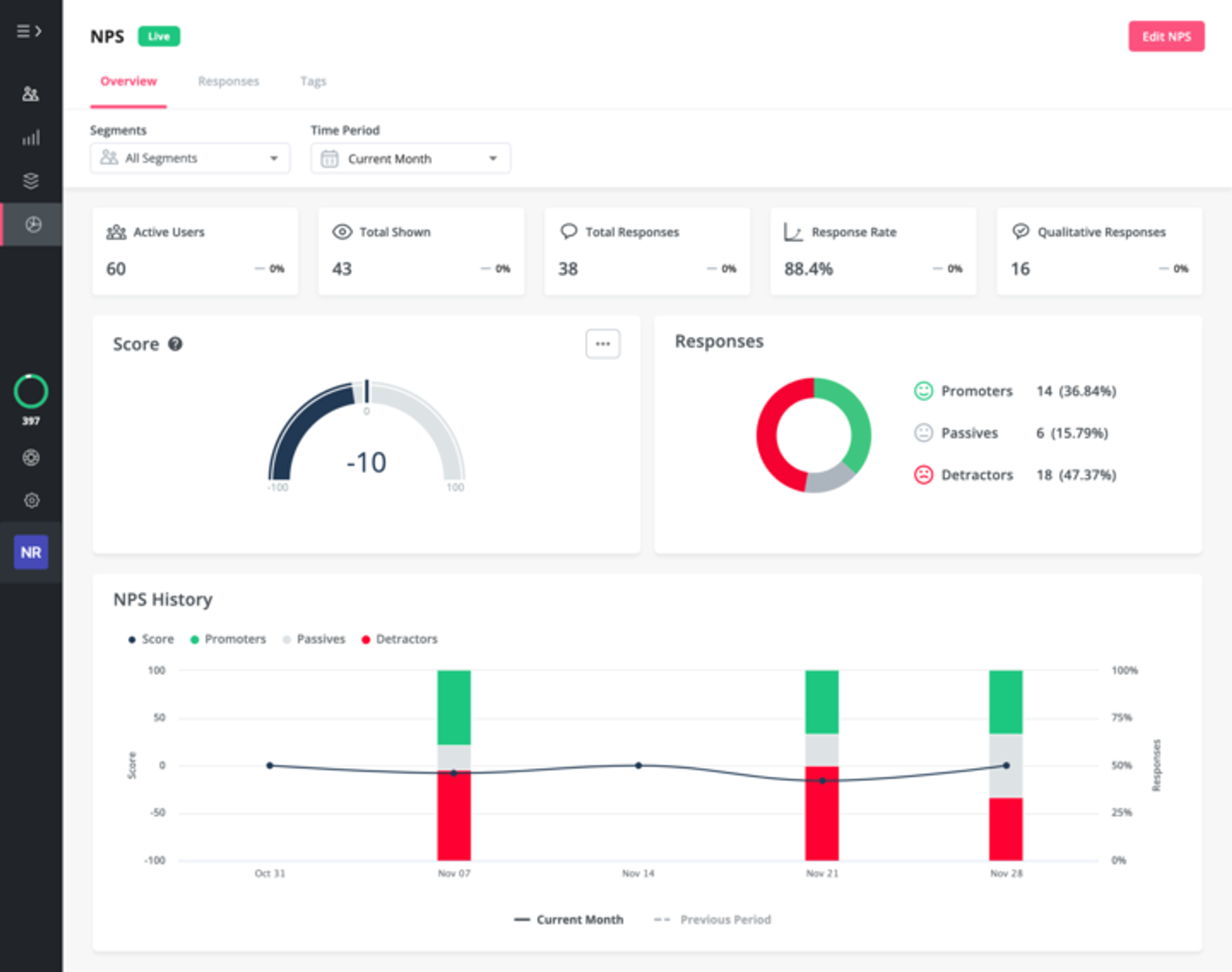
Userpilot’s NPS functionality.
- Launch product experimentation: built-in A/B testing for user flows lets you test product tours, and quickly iterate based on user behavior.
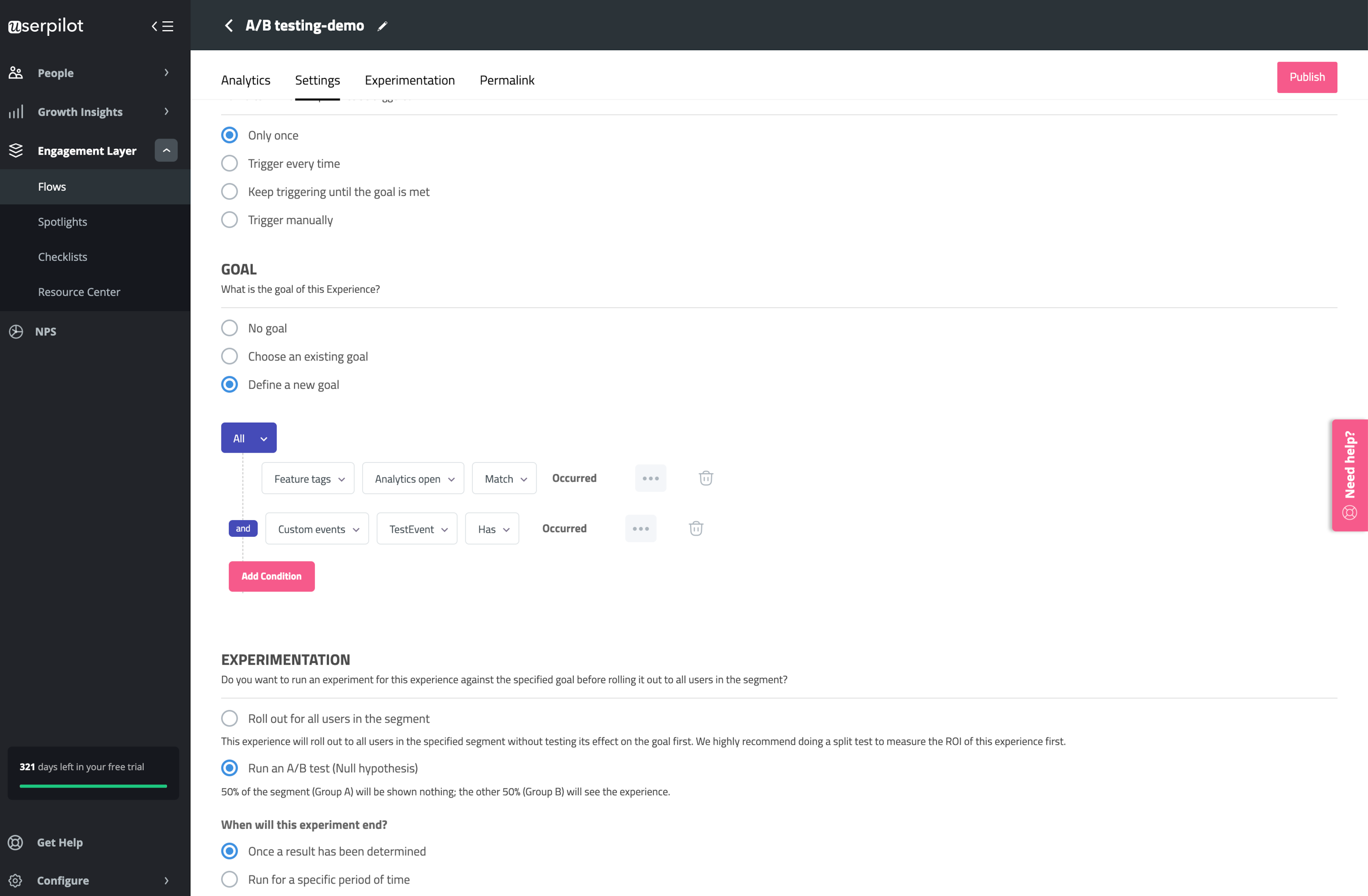
A/B test different onboarding flows with Userpilot.
- User analytics– With Userpilot’s powerful analytics that holds user event data, you can see how your users engage with the key features of your product, and your in-app experience. You can also monitor user productivity in-app to unveil friction.

Userpilot analytics.
- User segmentation – Build unlimited customer segments using demographic data, survey responses, in-app behavior, custom events, user and event attributes, and a lot more!
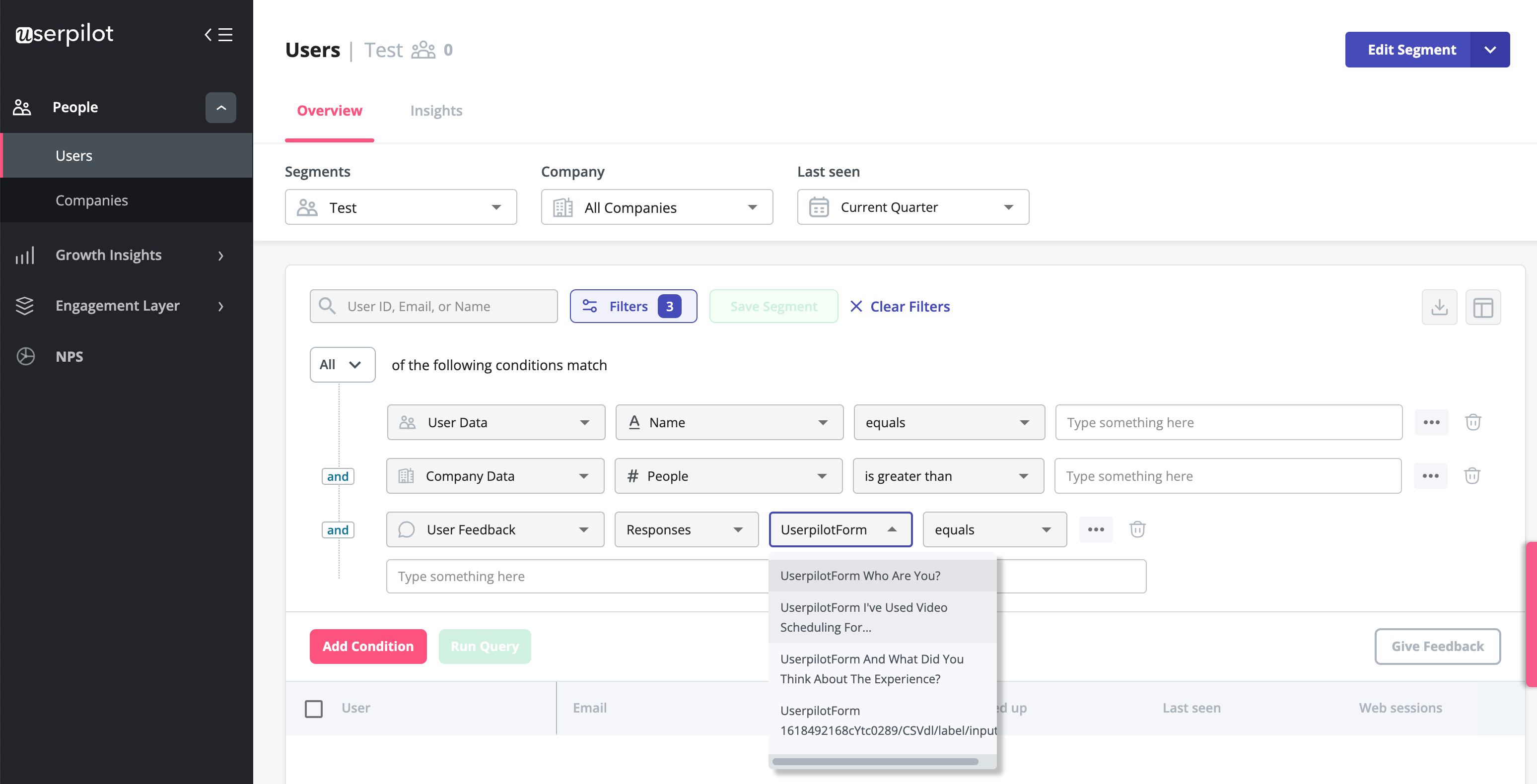
Segment customers with Userpilot.
Userpilot Cons
However, Userpilot has some cons:
- Browser/web app only: Userpilot won’t run on mobile devices/applications.
- Not suitable for employee onboarding: The tool is far better suited to user onboarding than for employee onboarding, as you can’t build in-app guides on third-party tools. You also can’t measure employee productivity.
- Integrations are limited: Hubspot and Zapier are coming soon, so if you need those integrations immediately you’ll have to wait.
- Price: Userpilot is a powerful, enterprise-level tool, and $249 a month might be too much of an expense for small companies as it’s not priced as per the monthly active user.
User personas Userpilot is most suitable for
- Mid-market SaaS companies with a product team – Userpilot is robust enough to meet your needs, and at $249 per month – affordable enough not to break the bank.
- Enterprises – thanks to being SOC 2 Type II certified and offering SSO and multi-user accounts, as well as offering bespoke Service Level Agreements, Userpilot is also suitable for enterprise clients.
However, if you are a really small startup and $249 per month sounds like a small fortune, and you don’t have anyone on your team to work on your onboarding and product adoption experiences – you may find that you’re not really making the most out of your Userpilot account. In that case – a simpler and cheaper tool will be better for you, as you won’t be using all of the Userpilot’s features anyway.
Userpilot pricing
Userpilot’s transparent pricing ranges from $249/month on the entry-level end to an Enterprise tier for larger companies.
Furthermore, Userpilot’s entry-level plan includes access to all UI patterns and should include everything that most mid-market SaaS businesses need to get started.

Userpilot has three paid plans to choose from:
- Starter: The entry-level Starter plan starts at $249/month and includes features like segmentation, product analytics, reporting, user engagement, NPS feedback, and customization.
- Growth: The Growth plan starts at $749/month and includes features like resource centers, advanced event-based triggers, unlimited feature tagging, AI-powered content localization, EU hosting options, and a dedicated customer success manager.
- Enterprise: The Enterprise plan uses custom pricing and includes all the features from Starter + Growth plus custom roles/permissions, access to premium integrations, priority support, custom contract, SLA, SAML SSO, activity logs, security audit, and compliance (SOC 2/GDPR).
![]()
Get the best value for money with Userpilot!

Userpilot reviews
Users have an overwhelmingly favorable view of Userpilot, citing usability, flexibility, and feature options.
“Userpilot is an incredible, user-friendly software that allows us to create unforgettable experiences for our clients! From basic to complex experiences, we have been able to do them all with ease! I would highly recommend this software to anyone who wants to provide their clients or users with the best product tour experience. The possibilities of what you can create are endless!”– Tayla G
Not to mention to support Userpilot offers in comparison to other tools.
“For the things I didn’t know how to do, I got the best support. Their support is always available if you need it. A fast response time, and informative training webinar sessions. I’m a fan.”– Jose I
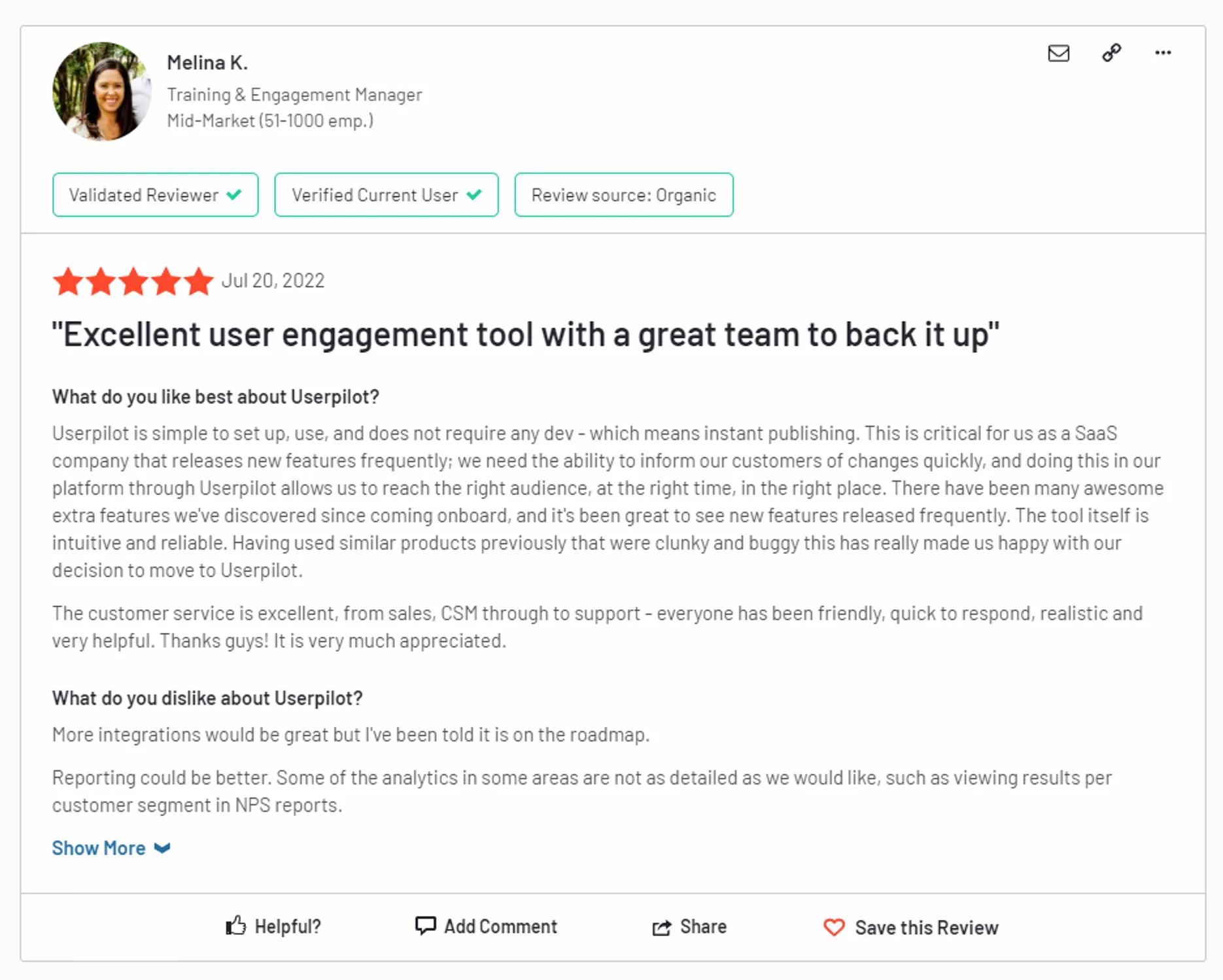
A customer review about Userpilot.
Top Userpilot alternatives you may want to consider
Now that we have learned about Userpilot’s functionality and suitable user personas, let’s see how other alternatives to Userpilot compare to each other.
Best Userpilot alternative – Appcues
Appcues is one of the earliest players on the onboarding scene and offers a really solid user onboarding tool for mid-market SaaS.
It lacks certain features, UI patterns, and actions that Userpilot has to offer, and comes with a much higher price tag if you need to use more than a few segments, custom events, and goals – but on the other hand, offers a wider selection of integrations and a nicer UI.
So again, it all depends on what is your top priority!
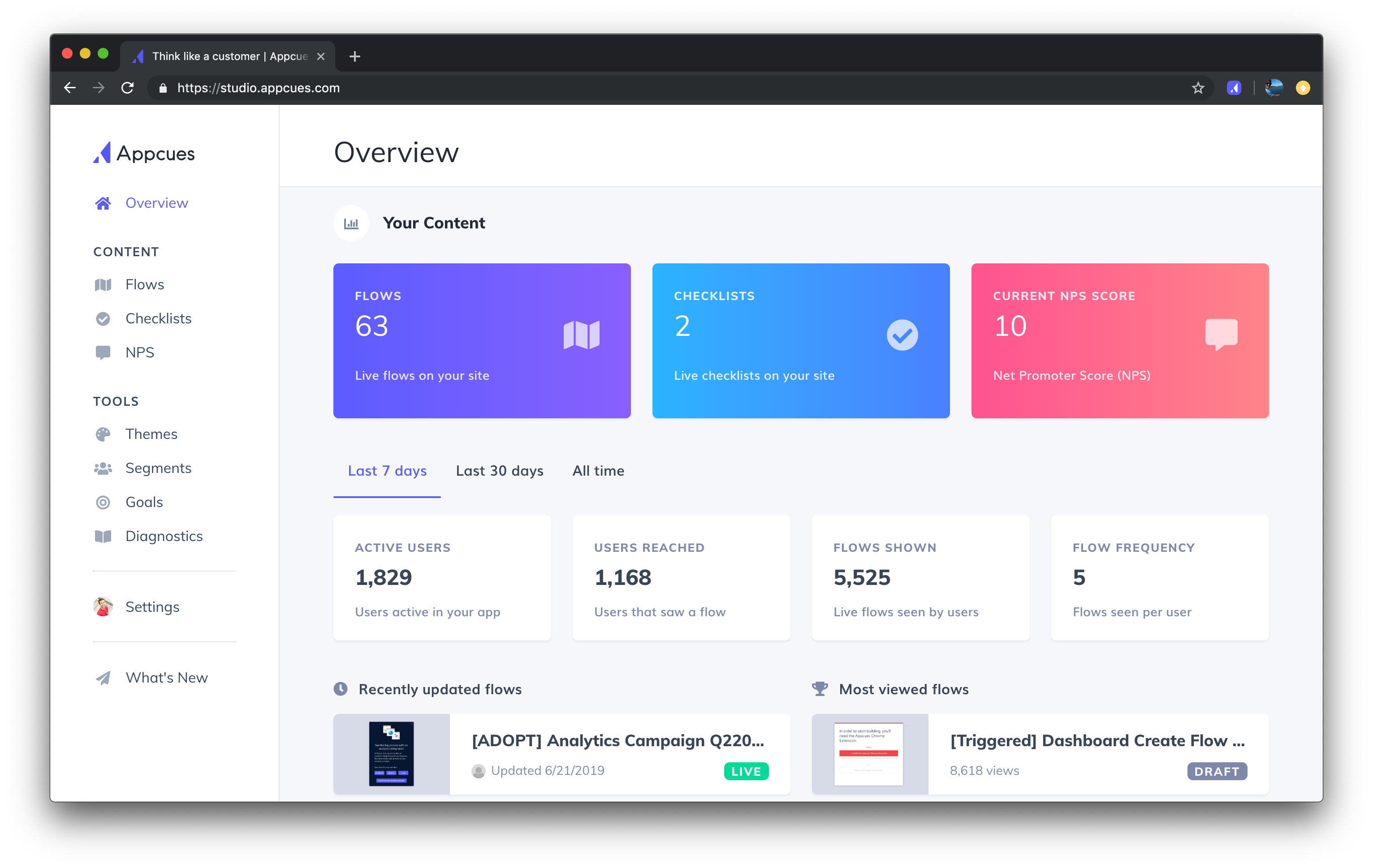
Appcues dashboard.
Appcues features and functionality
Here’s a short summary of Appcues’ upsides and shortcomings, and the differences between Userpilot and Appcues:
- Access to an easy-to-use UI that anyone on the team can handle for building in-app flows without coding.
- Building a product tour in Appcues is relatively easy. You just need to open their chrome extension on top of your application and start building your in-app experiences with a WYSIWYG editor. You simply select a UI pattern and customize it ‘live’, or point to the elements you want to e.g. append your tooltips to.
- You can also create checklists with Appcues (NOT available on the Essentials plan) and prompt users to take action. These are ok but have limited functionality (can’t trigger JS functions, or add gamification elements) compared to alternatives, such as Userpilot.
- Track UI engagement with Events explorer which allows you to tag elements without coding.
- Build custom user segments (up to 5 on the Essentials plan) based on user properties, flows, interactions, or events you set up in the events explorer.
- Unlike its alternatives, Appcues doesn’t offer an in-app Resource Center.
- You can build and trigger NPS surveys in-app without coding. Target the survey at a specific user segment (or choose one of the predefined segments) and adjust the survey display frequency.
- You can also collect user feedback with short surveys built on top of modals: add numerical scale, open-ended questions, or radio button questions.
- On the flip side: you can’t tag your NPS/survey responses in-app and use these tags to segment your audience by them.
- You can’t analyze the responses in-app. You can only download a CSV report to start analyzing your data – and we all know how time-consuming that is.
Appcues Pricing
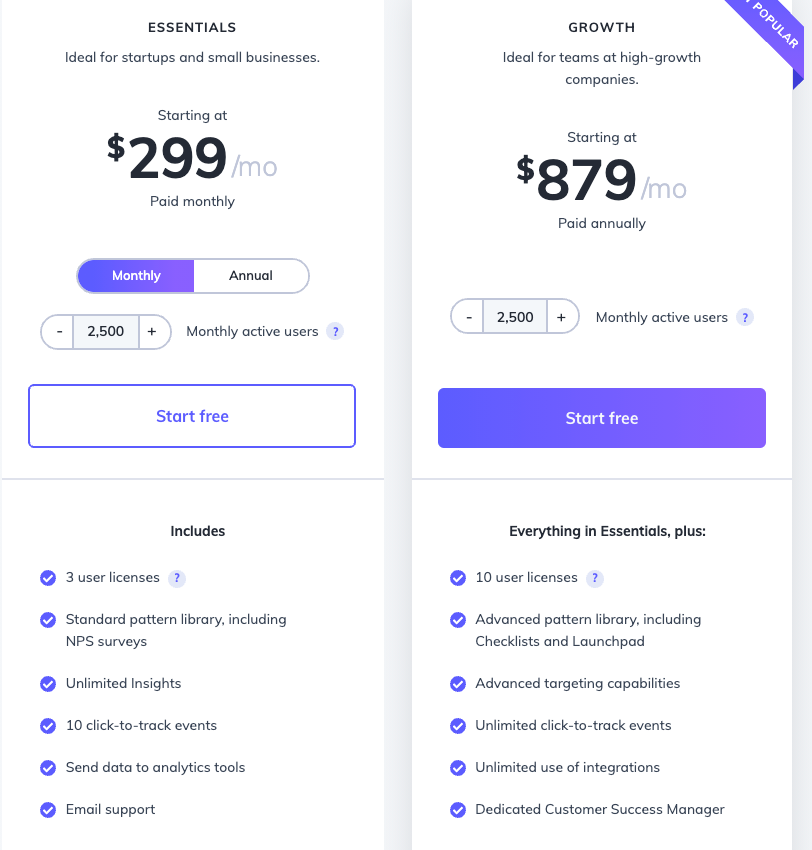
Appcues pricing.
Appcues pricing starts at the same rate as Userpilot’s – $249 for 2,500 MAUs. However – there’s a catch. The ‘Essentials’ plan limits your feature use, i.e. to 5 user segments, 10 goals, and 10 custom events. So if you want to use any analytics or personalize your onboarding through segmentation, you will need to upgrade to the growth plan very quickly.
![]()
There is a better alternative than Appcues!

Alternative to Userpilot – Pendo
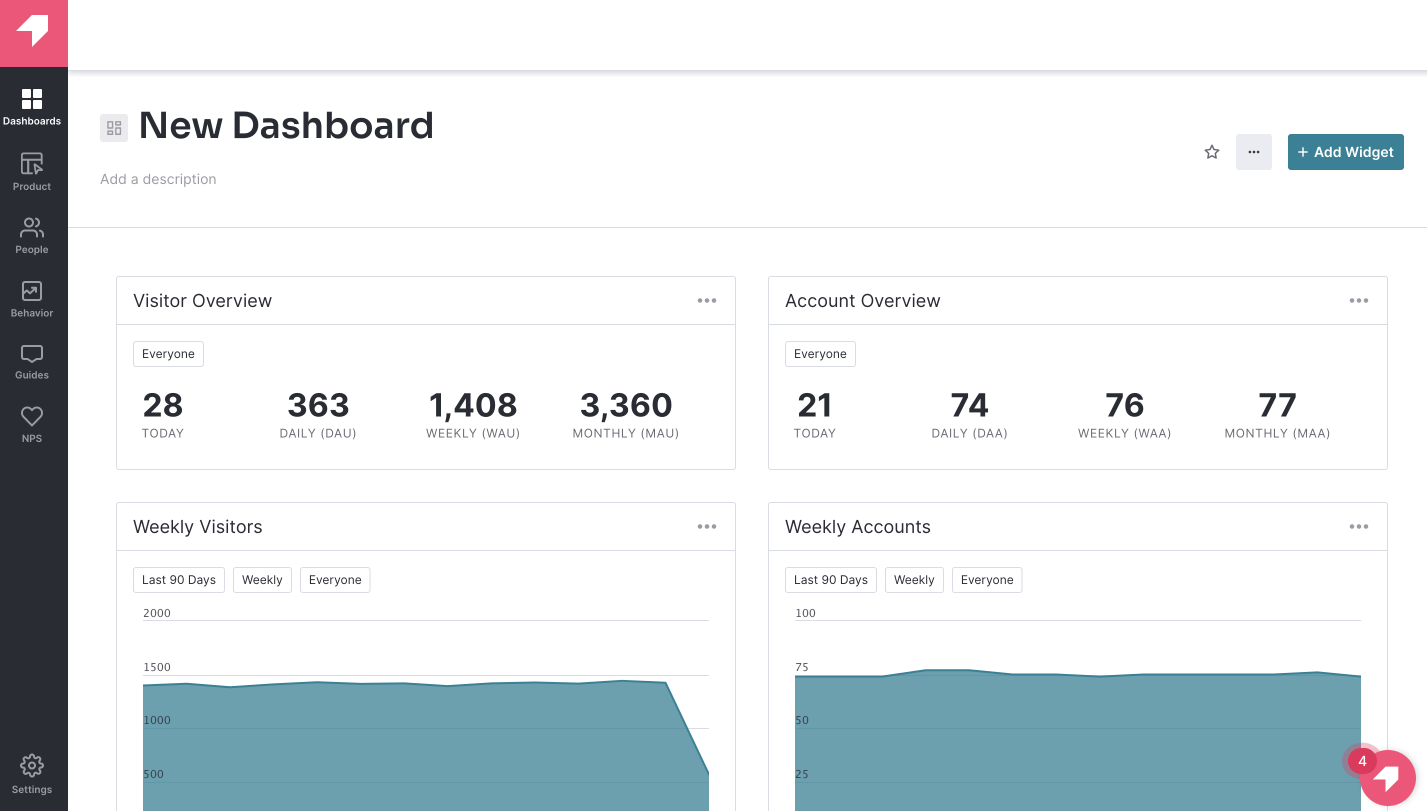
Pendo dashboard.
Another alternative to Userpilot is Pendo. Pendo offers a comprehensive solution for user onboarding, analytics, performance support, and in-app feedback. Let’s see its strengths, weaknesses, and differences from Userpilot:
- You can build guides using templates, and there’s also a WYSIWYG (what-you-see-is-what-you-get) visual design studio editor for creating new designs from scratch.
- You can use Pendo’s free version to create user onboarding guides, but you’ll only get access to limited features and basic analytics.
- Types of guides you can create using Pendo include Lightbox, Banner, Tooltips, Polls, and Walkthroughs. The drawback with them is that they are quite basic and don’t allow much customization without coding. Even Pendo’s own onboarding guide is a series of purple tooltips.
- You can also build checklists with Pendo but not as standalone UI elements as users can only access them from the resource center (if they know they exit). This makes it hard and not intuitive for users to access guidance and overall defeats the purpose of using checklists.
- Pendo product guidance for mobile works across Android and iOS mobile apps, so if you’re looking to support your mobile customers through their onboarding, Pendo might be for you (be aware that Pendo for mobile guides is not included on the free plan).
- You can use Pendo’s free version to create guides, but you’ll only get access to limited features and basic analytics.
- Pendo’s feedback allows you to add short polls on your guides and UI patterns built with Pendo. You can use only text polls, yes/no polls, numbered scales, or multi-choice polls and add them as building blocks when building the guides.
- There’s not a lot of customization, like themes or emojis available, but it’s enough to collect data in-app. If you are willing to pay for the Growth plan, you get access to Pendo’s NPS feature too.
- The downside of using Pendo for collecting user feedback is that you can’t use the insights to personalize the user experience. For example, you can’t create user segments based on NPS scores or specific answers you collect with your polls. Considering the price you have to pay for Pendo, you’d expect more from it.
Pendo Pricing
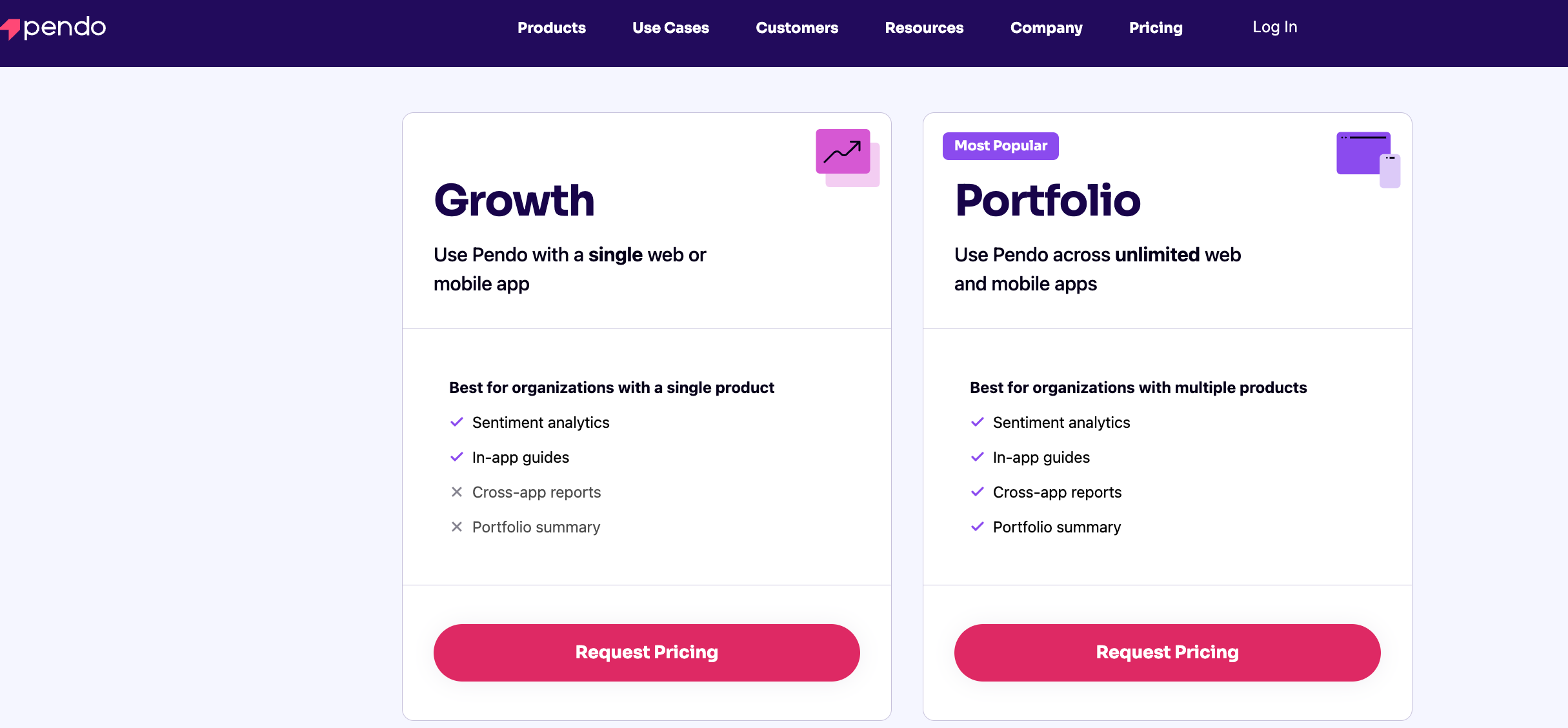
Pendo pricing.
The tricky part when it comes to Pendo’s pricing is that you get to pay separately for different modules:
- Pendo Free: Up to 500 MAU, single-app, and basic functionality and analytics.
- Pendo Starter: 2,000 MAU limit, single-app, and access to premium features.
- Pendo Growth: Custom MAU, single-app, NPS and PES, Resource Center, and access to support compared to lower plans.
- Pendo Portfolio: Custom MAU, multi-app, cross-journey reports, experimentation, and 1 free integration included.
- Pendo Feedback: Collecting feature requests is a separate module with custom pricing.
- Pendo Integrations: Synchronizing Pendo with your integrations is a separate module with custom pricing.
- Pendo Adopt: Employee onboarding is a separate module with custom pricing.
![]()
There is a better alternative to Pendo!

Userpilot alternative – UserGuiding
UserGuiding is misleadingly similar to Userpilot in terms of UI, but in terms of UX and reliability – it’s like a lot of cheaper copies of the original – often unreliable and buggy.
It allows you to build some simple product tours, collect some user feedback and launch an NPS. But it’s not a fully-fledged product growth platform.
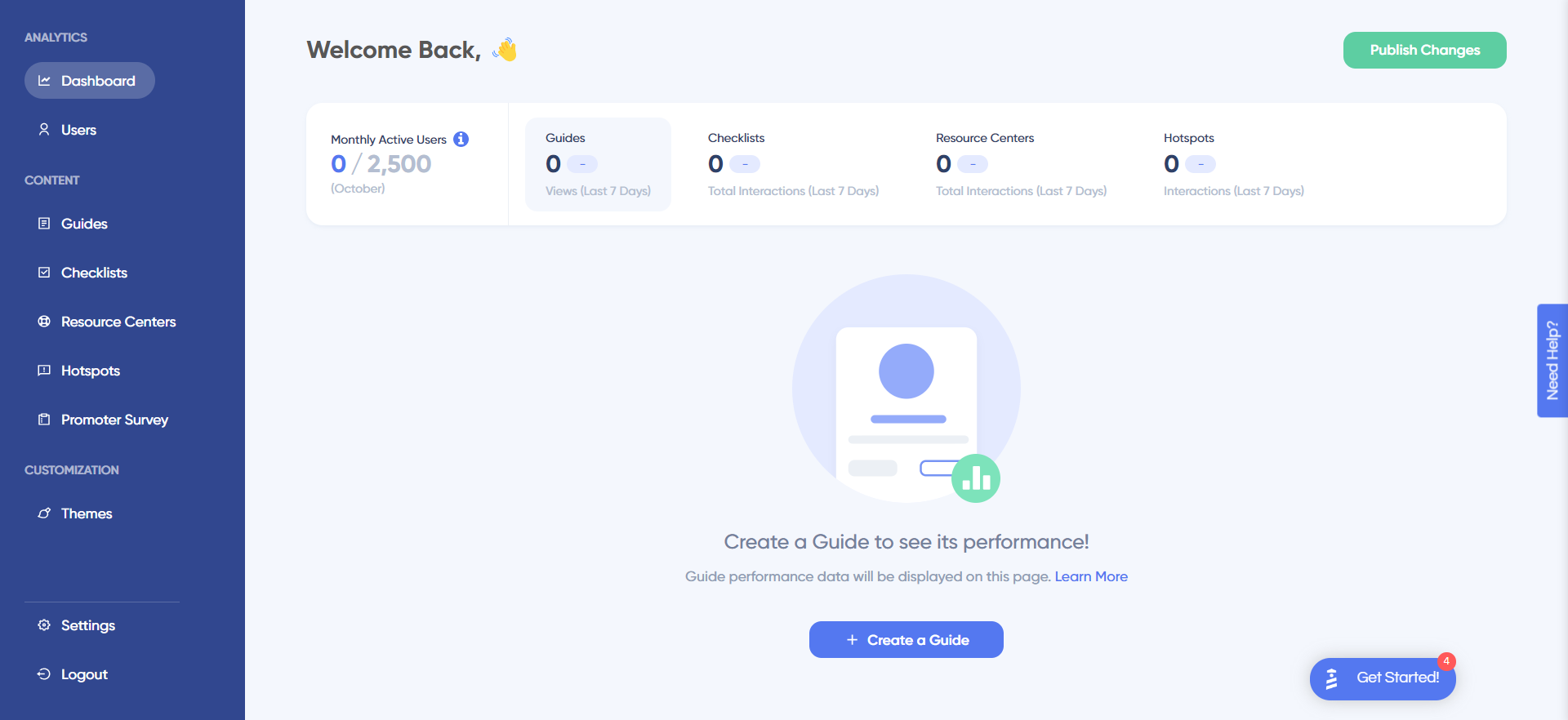
UserGuiding dashboard.
Let’s see its strengths, weaknesses, and differences from Userpilot:
- Create interactive product walkthroughs without disturbing your developers as it’s completely code-free.
- Use a variety of UI patterns, like checklists, tooltips, modals, and slideouts to prompt the right in-app experience, to the right persona, at the right time in their user journey.
- Add emojis, gifs, images, or videos to customize your onboarding flows and have them match your brand.
- For small startups or independent businesses, the price is an attractive element to consider.
- Though UserGuiding does have analytics functionality, it’s not complex and doesn’t give you much data.
- Unlike some of the more expensive options, you can choose to add a Resource Center (a bonus for self-service support).
- For a budget tool, UserGuiding still offers integrations with other applications, such as Mixpanel, HubSpot, Woopra, Slack, Webhook, etc.
- There are many bugs and performance issues when using the tool. The UI is also fairly tricky to navigate.
- It has limited functionality, particularly on the basic plan. There you only have a small range of features available – all with the UserGuiding watermark/branding.
- Technical knowledge is required to get the maximum out of this product.
- Customization and design options for UI patterns aren’t the greatest.
UserGuiding Pricing
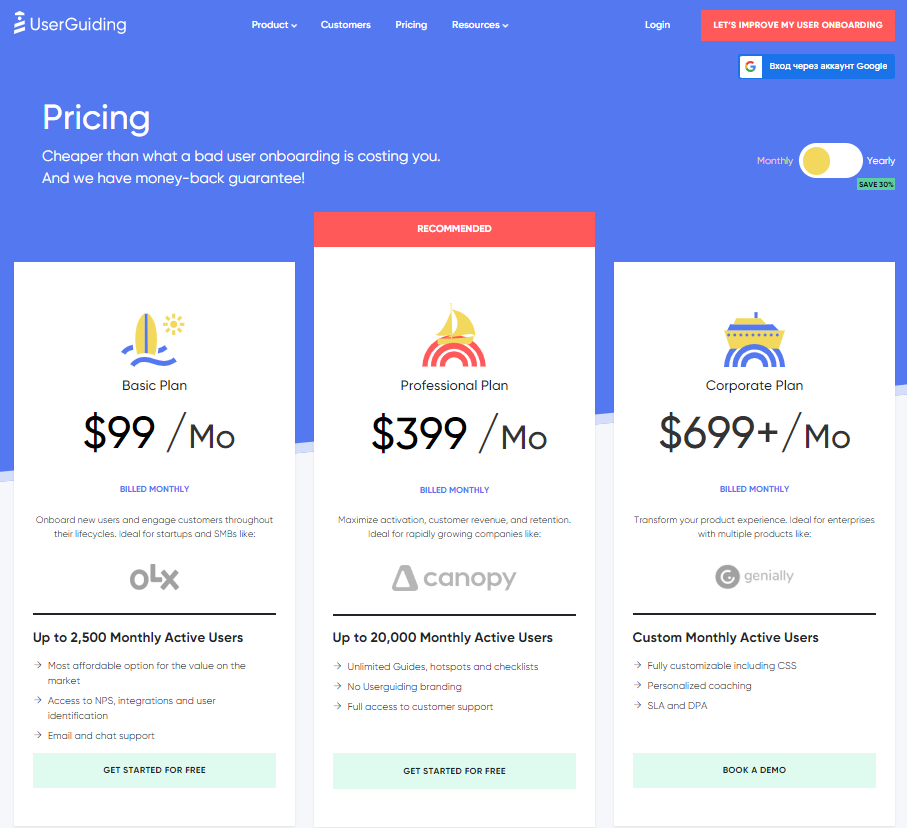
UserGuiding pricing.
UserGuiding’s pricing model is far simpler than others on our list. There are three tiers, each one charging a set amount for access to certain tools.
Here are its packages:
- Basic will give you access to only the most essential onboarding tools: Starting at $99/mo or $69/mo (if you buy the yearly contract), this budget option has a few limitations to consider (i.e., just 1 Team Member, a limit of 20 guides, and 2 checklists, UserGuiding branding on all UI patterns).
- Professional adds unlimited guides, hotspots, and checklists. Starting at $399/mo or $299 /mo if billed yearly.
- Corporate gives you access to everything plus personalized coaching. Starting at $699/mo or $499/ mo for a yearly plan.
![]()
Considering UserGuiding? Try Userpilot!

Userpilot alternative – Walkme
WalkMe is one of the pioneers in the market of adoption tools. It is a cloud-based digital adoption platform that allows you to create product tours and in-app experiences to drive customer onboarding and digital adoption.
WalkMe is best for enterprise companies as they are focused on employee onboarding rather than user onboarding.
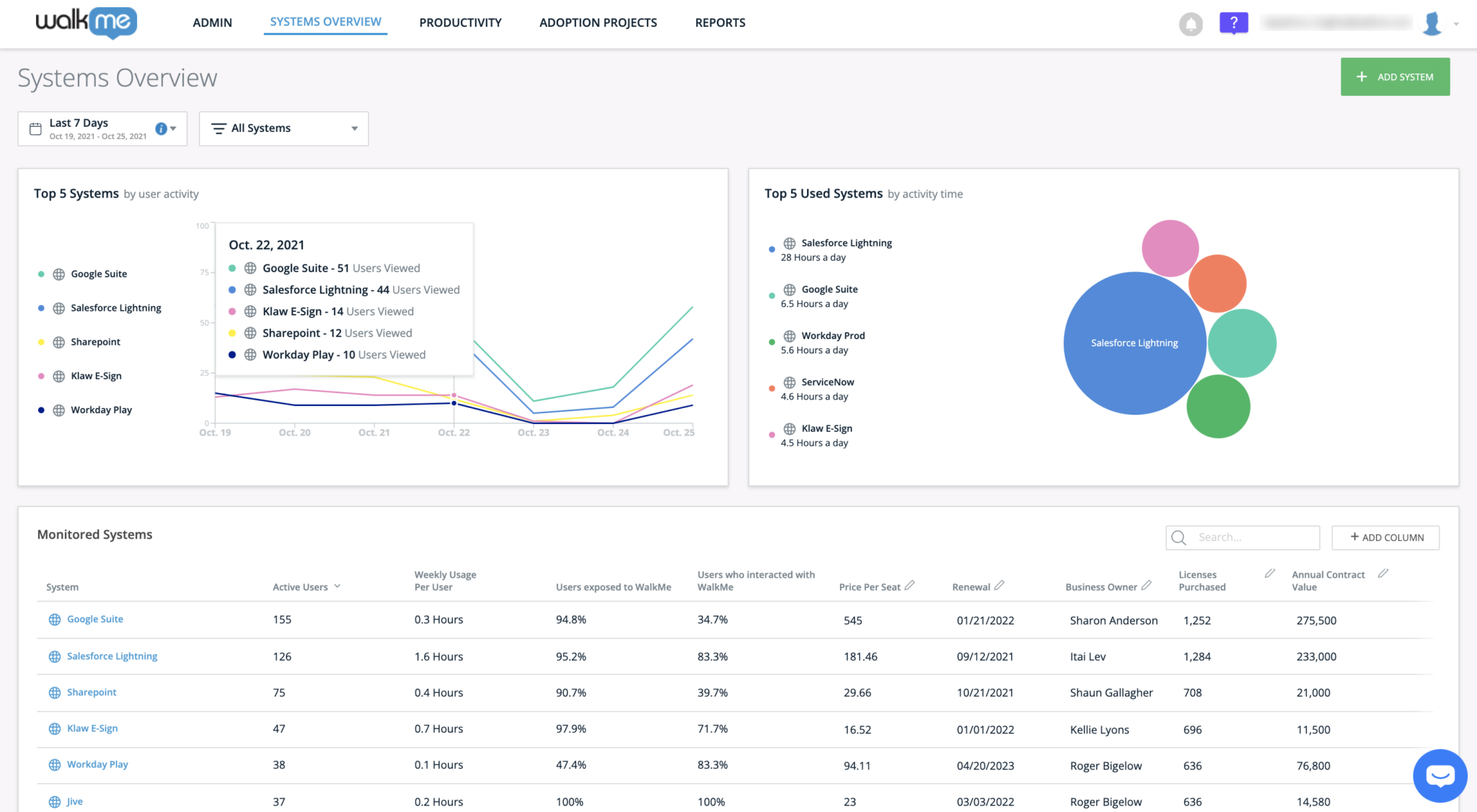
Walkme dashboard.
Here’s what you’ll get when you start using Walkme:
- WalkMe’s WalkThrus are its primary engine for creating user onboarding experiences. They overlay the target software or web app and provide on-screen guidance to help users complete tasks. In most cases, this means step-by-step instructions and tips that lead users from a starting point to the completion of a given task.
- SmartTips are also a form of on-screen guidance, but they’re less about the process and more about resolving points of friction. For example, with a SmartTip you can trigger a small note to pop up suggesting relevant links or giving more information about how to complete a form.
- ShoutOuts operate like SmartTips, but are geared toward in-product messaging. You can trigger them to pop up and give more information about relevant features, new updates, or product promotions.
- WalkMe also offers a couple of other more niche features for onboarding. For example Launchers (buttons that launch other WalkMe features or experiences), surveys, and an ActionBot (automated chatbot to help users resolve issues and answer questions).
- There’s a steep learning curve and a fair amount of technical knowledge required to create WalkMe user guides and get them implemented the way they’re intended.
- WalkMe is designed for enterprise organizations, and its pricing reflects that.
- You could end up spending anything from $9000 to $50000 a year on WalkMe. That’s a lot of money for startups and SMEs.
Walkme Pricing

Walkme pricing.
WalkMe works on a custom pricing plan that requires you to request a quote from their sales team (could be spending from $9000 to $50000 a year).
Their main plans are:
- WalkMe for employee onboarding experience: engagement tools and analytics.
- WalkMe for customer experience: engagement tools and analytics.
- Add-ons: Session Streams, TeachMe, AI analytics through UI intelligence.
![]()
There is a better alternative to Walkme!

Conclusion
Well, as you might have expected from the title of this talk – there is no one-size-fits-all. We have compiled a list of Userpilot alternatives that depend on your final goal.
The best onboarding tool for you depends on your company size, product teams, and use case.
If you need any help we are always happy to jump on a call with you!
![]()
Try the best onboarding tool for your SaaS now!


